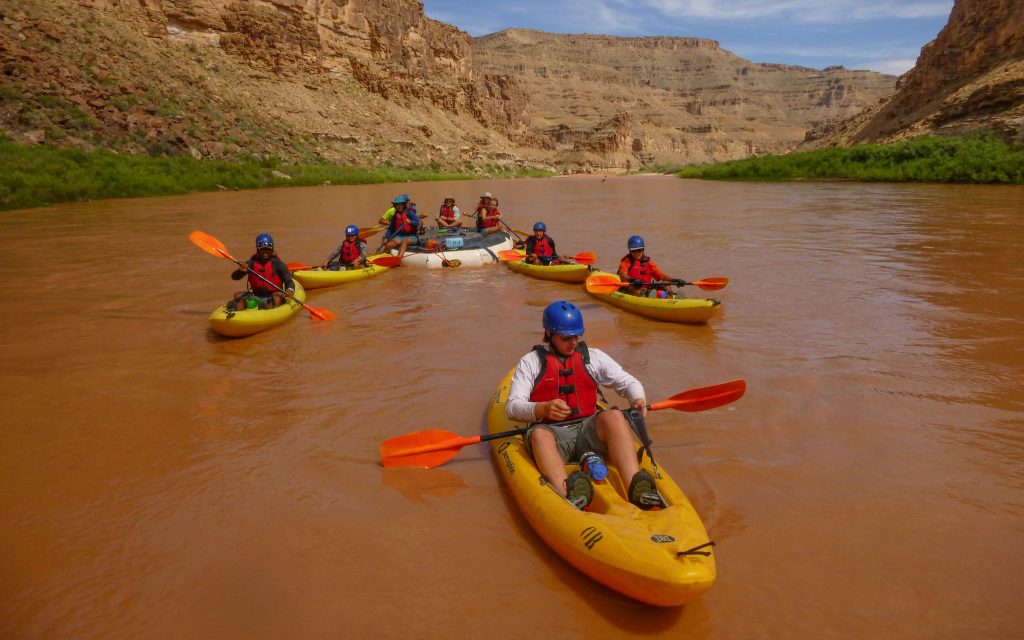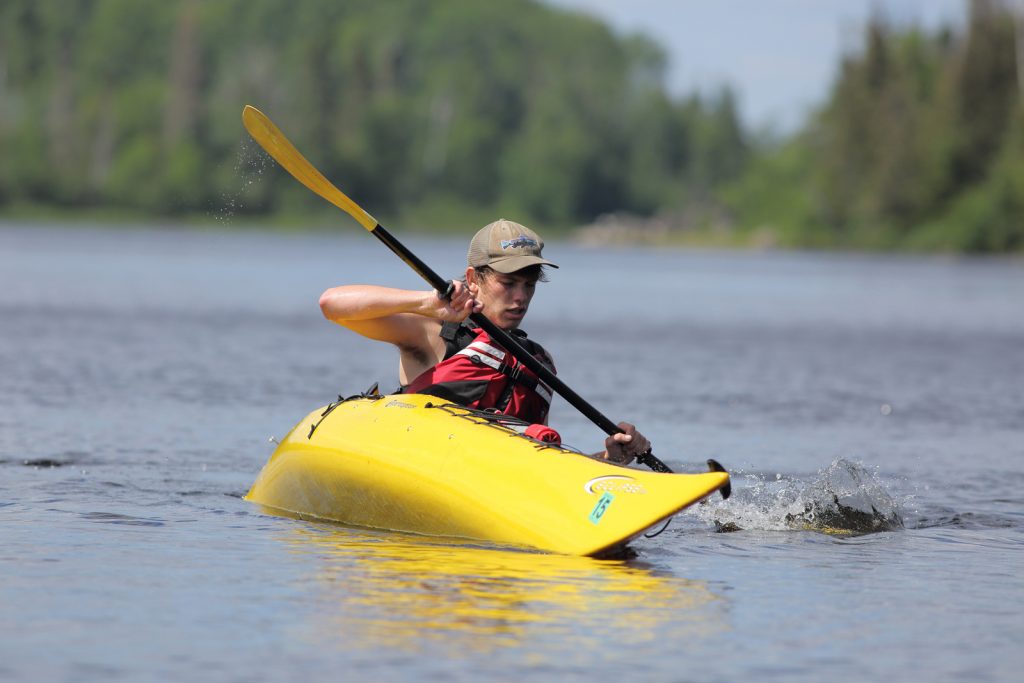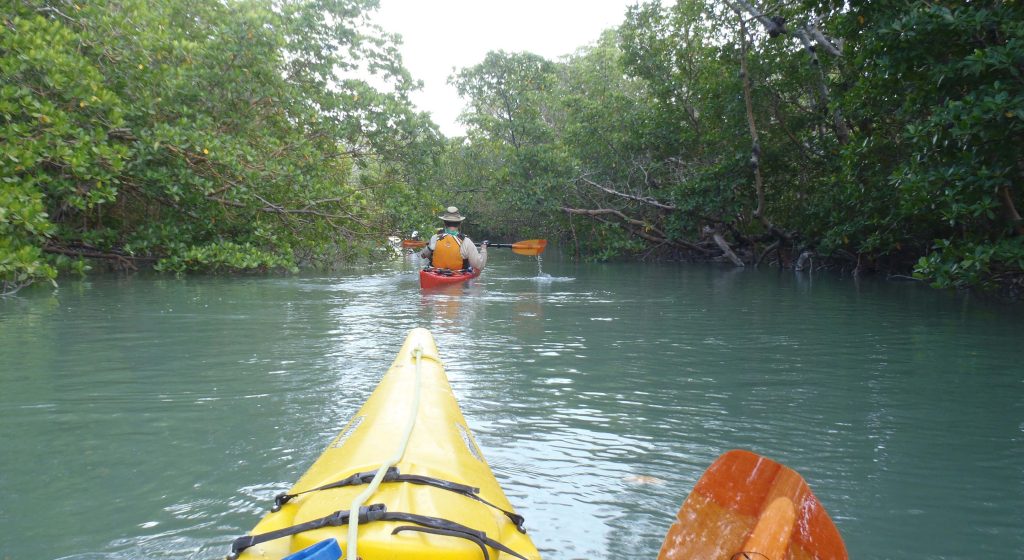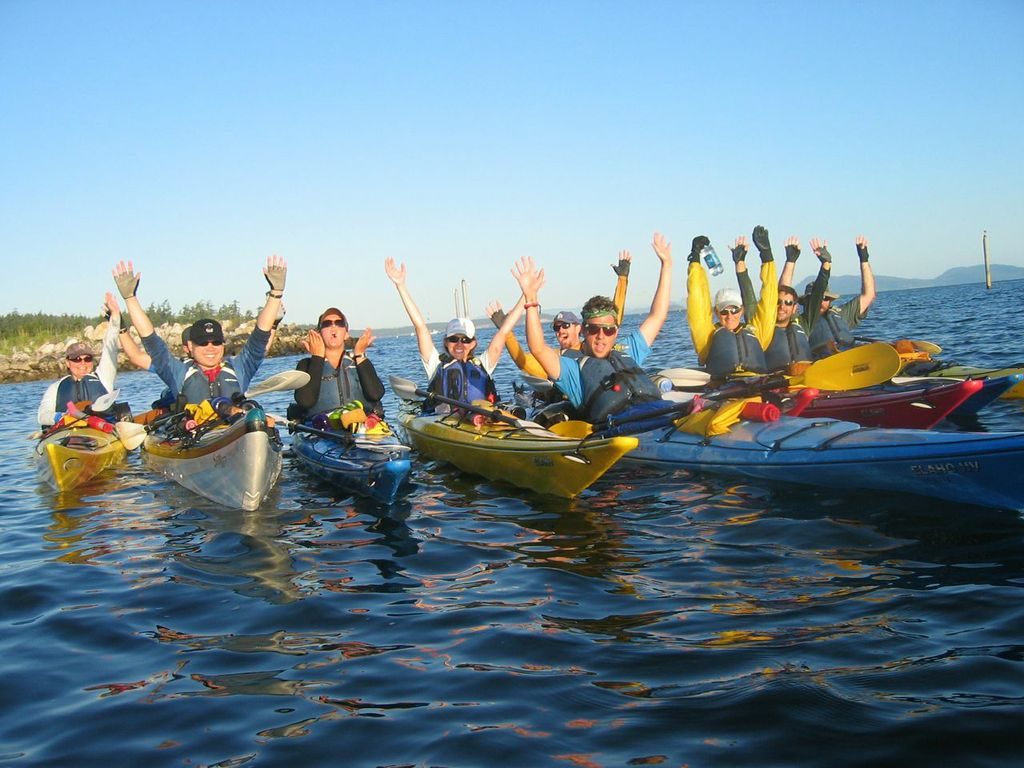If you’re like me, your heart races when you look at Outward Bound courses. The silhouetted figures of people in kayaks against blood orange sunsets always makes me ready for adventure. It reminds me of how daunting kayaking felt at first, and how fiercely I avoided it because I didn’t know how it worked.
Outward Bound Instructors don’t expect students to have any technical knowledge of kayaking before their courses. If anything, it’s easier to teach people something new, instead of correcting old habits. If you’ve never been in a kayak before, don’t worry, it’s likely you’re in the same boat as everyone else.
Sit-On-Top River Kayak
Kayaks can vary from course to course depending on the region. If you take a kayaking course in Utah, where you’ll be running a river, you’ll probably use a sit-on-top river kayak.

Photo taken on a Southwest Rafting & Kayaking course by Katie Gregory
Sit-on-top river kayaks are shorter in order to make hairpin turns and are wider for stability. The passenger sits on top of the kayak instead of inside of it. The kayak usually has straps to loop over the tops of the passengers’ knees so he or she can remain upright as they lean from side-to side through waves.
Sit-In-Sea Kayak
If you take a course with kayaking on open water like in the San Juan Islands of Washington, you’ll use a sit-in-sea kayak.

Photo taken on a Lake Superior Sea Kayaking & Backpacking for Adults course by Larry Mishkar.
Sit-in-sea kayaks are designed for the open water where conditions can present wind, waves and long distances between destinations. These kayaks are usually very long and sleek in order to cut through waves and capture as much efficiency as possible between paddle strokes. The passenger sits inside of these boats, and a spray skirt is worn around the waist and pulled over the cockpit of the craft to keep water from flooding the boat. These kayaks are appropriate for oceans, large lakes or bodies of water where one may experience choppy water when traveling long distances.
How stable are the boats?
The stability of the boat depends on the passenger inside of it. If the person inside of the boat is very tense and makes jerky movements the boat will feel tippy and unsteady. If the person inside of the boat is relaxed and absorbs small nudges from wind and waves, the boat will feel steadier. As noted above, the wider the kayak, the sturdier it will feel. However, the downside is that wider kayaks are not efficient for traveling long distances.
How cold is the water?
Water temperatures depend on the course areas. If you take a course in the San Juan Islands of Washington, the water can be as cold as 50 degrees in the dead of summer, whereas water temperatures in Everglades National Park can reach 70 degrees!

Photo shows students using their kayaking skills in the Everglades National Park in Florida.
What if I’m not a strong swimmer?
Being a strong swimmer isn’t required to become a strong kayaker. Our students are of all shapes, sizes and abilities. Each student will be outfitted with a PFD or Personal Flotation Device. This vest, previously known as a Life Jacket, keeps our students buoyant enough to be able to tread water toward their intended destination.
What do I wear when I go kayaking?
Students wear insulated booties or water shoes, neoprene garments, synthetic layers, light paddle gloves, hats and sunglasses. This attire can change course to course or even day to day depending on the weather. When students enroll in a kayaking course, they are sent a comprehensive clothing list which outlines exactly what they will need. Outward Bound provides most technical gear, such as wetsuits.
What if I tip over?
If you tip over, it’s not the end of the world! Instructors brief students, in detail, what to do if they tip over. Students will learn how to get back inside of their kayak using a variety of techniques such as a paddle-float assisted re-entry, rodeo re-entry, wet roll or partner assist. The Instructors explain all of these techniques, and students have plenty of time to practice well before there’s a chance to tip over.
What safety techniques will I learn?
Instructors cover all kayaking safety topics which range from verbal and visual communication, personal attire, planning ahead and preparing to reading tide charts, river levels and weather conditions. Safety topics also cover wet exits, assisted and self-rescue techniques and towing. Students also learn how to position and maneuver their boats in order to get to the safest location like an eddy or a kayak pod.
What is the difficulty level?
Kayaking can be challenging! Participants should expect long days on the water exercising core and upper body muscle groups. They should expect to fully submerge themselves in the water in order to learn safety techniques like getting back into a boat. They should also expect to carry sometimes heavy gear like water jugs to and from boats once on shore. Like all courses, there are physical and mental challenges, but your Instructors want you to succeed and will do everything in their power to help you achieve your goals.
Will there be any time on land?
Yes, of course. Most kayaking courses include short hikes or walks to explore the areas. Students can expect to spend the majority of daylight hours on the water minus a lunch break unless there are scheduled hikes or itinerary exceptions.
How do we carry all of our camping gear?
On river trips, the student and group gear is stored on a large gear boat that travels with the group downstream. On other kayaking trips, each student will carry their personal gear plus a small amount of group gear, food and water in the storage hatches of their boats.
What about fresh water?
Aside from the water that the group starts off with, fresh water is collected from natural sources and treated to become safe drinking water. In some situations, groups are able to fill up their water supplies at nearby spigots from recreation areas or state parks.
What else will I learn?
Courses will focus on history, anatomy and handling of the boats. They will cover attire, safety, technique, Leave No Trace (LNT) and camp craft skills required when traveling by kayak. Students will also learn how to function as a member of a group expedition. On Outward Bound courses, students are crew, not passengers.

On every Outward Bound course, students learn they are crew, not passengers. Photo taken by Luke O’Neill.
Will I be able to go kayaking on my own after a course?
Possibly! We highly recommend putting your newly learned skills to use after a realistic assessment of your capabilities and gear. Our courses offer basic, intermediate and advanced teachings as well as student evaluations and support.
Contact us if you have questions or want to speak to an Admissions Advisor about a kayaking course.
About the Author
Trevor McKee embodies and models the spirit of Outward Bound every day. As a three-time alumni, Instructor since 2009 and Course Advisor for the Northwest Outward Bound School, Trevor has served many sides of the School. He can often be found volunteering and doesn’t feel fulfilled without incorporating service into his life. Trevor also believes in making Inclusion and Diversity a reality in his community. He co-produces the Queer Adventure Storytelling series in Portland, Oregon. Trevor credits his pivotal experiences as a student for giving him the tenacity to pursue his dream of hiking from Mexico to Canada twice. He believes every person should have the opportunity to challenge themselves on an Outward Bound course to realize they are capable of more than they ever thought possible.
OTHER POSTS YOU MAY LIKE
Read More
Read More
Read More




